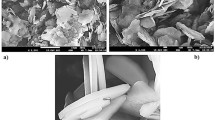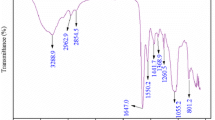Abstract
The current study deals with the fabrication of crosslinked epoxy composites reinforced with several loadings of aluminum nanorods (i.e., 5, 10, 15 and 20) wt% by a hand lay-up technique. Both pyromellitic dianhydride and glycerin utilized as cross-linker agents. The thermal, morphological and mechanical properties of the resultant composites were characterized as a function of nanorods content and type of cross-linker using a wide range of analytical and testing techniques. The results showed that using a combination of pyromellitic dianhydride and glycerin provide more adhesion efficiently between the nanorods and epoxy compared to the individual cross-linker. Also, the results demonstrated that both tensile and flexural strengths, and their moduli were increased with adding nanorods content up to 15 wt% followed by the moderate improvement. The maximum value of tensile, flexural strengths, tensile modulus and flexural modulus are ~ (6000, 96, 5000, 10,000) MPa, respectively; for crosslinked epoxy composites, which are higher than of pure epoxy by ~ (20, 37, 56, 53)%. Comparably, thermal degradation temperature (i.e., 300 °C) of the plain epoxy is shifted slightly toward higher temperature after the cross-linking reaction, which is likely due to a good interaction between epoxy molecules leads to an improvement in the thermal stability of the composite materials. In addition, both glass transition and melting temperatures of the crosslinked epoxy samples increased from by 37.6% and 11.7%, respectively. These results correlate with images from scanning electron microscopy, which showed less agglomeration and good distribution of nanorods particles into the crosslinked epoxy matrix.









Similar content being viewed by others
Data availability
All data generated or analyzed during this study are included in this published article.
References
Zhang H, Tang L, Liu G, Zhang D, Zhou L, Zhang Z (2010) The effects of alumina nanofillers on mechanical properties of high-performance epoxy resin. J Nanosci Nanotechnol 10:7526–7532
Kareem AA, Rasheed HKh (2019) Electrical and thermal characteristics of MWCNTs modified carbon fiber/epoxy composite films. Mater Sci-Pol 37:622–627
Kareem AA (2020) Enhanced thermal and electrical properties of epoxy/carbon fiber–silicon carbide composites. Adv Compos Lett 29:1–6
Hassan DJ, Ali NA (2022) Evaluation of mechanical properties for epoxy reinforced with palm oil /zinc oxide composites. Iraqi J Phys 20:26–37
Songa J, Chena G, Wu G, Caia Ch, Liud P, Lia Q (2011) Thermal and dynamic mechanical properties of epoxy resin/poly(urethane-imide)/polyhedral oligomeric silsesquioxane nanocomposites. Polym Adv Technol 22:2069–2074
Liu S, Zhang H, Zhang Z, Sprenger S (2008) Tailoring the mechanical performance of epoxy resin by various nanoparticles. Polym Polym Compos 16:527–533
Shundo A, Aoki M, Yamamoto S, Tanaka K (2021) Cross-linking effect on segmental dynamics of well-defined epoxy resins. Macromolecules 54:5950–5956
Abdulnabi RJ, Kareem AA (2022) Fabrication and characterization of high-performance crosslinked PVA/ PMDA doped with H2SO4. Iraqi J Sci 63:2006–2016
Hameed N, Eyckens DJ, Long BM, Salim NV, Capricho JC, Servinis L, De Souza M, Perus MD, Varley RJ, Henderson LC (2020) Rapid cross-linking of epoxy thermosets induced by solvate ionic liquids. ACS Appl Polym Mater 7:2651–2657
Deyaa BM, Hameed TM (2017) A study of the effect of nano materials on the physical properties of epoxy composites. Iraqi J Phys 15:68–76
Jeonga K, Lia Y, Yooa D, Leea N, Leea H, Andob Sh, Ha Ch (2018) Effects of cross-linking agents on the physical properties of polyimide/amino-functionalized graphene oxide hybrid films. Polym Int 67:588–597
Nikolic G, Zlatkovic S, Cakic M, Cakic S, Lacnjevac C, Rajic Z (2010) Fast fourier transform IR characterization of epoxy GY systems crosslinked with aliphatic and cycloaliphatic EH polyamine adducts. Sensors 10:684–696
Wang Y, Gan H, Liang C, Zhang Z, **e M, **ng J, Xue Y, Liu H (2021) Network structure and properties of crosslinked bio-based epoxy resin composite: an in-silico multiscale strategy with dynamic curing reaction process. Giant 7:1–15
Khorasani MGZ, Silbernagl D, Szymoniak P, Hodoroaba V, Sturm H (2019) The effect of boehmite nanoparticles (γ-AlOOH) on nanomechanical and thermomechanical properties correlated to crosslinking density of epoxy. Polymer 164:174–182
Othman RNR, Subramaniam DK, Ezani N, Abdullah MF, Ahmad KZ (2022) The synergistic effects of hybrid micro and nano silica in influencing the mechanical properties of epoxy composites—a new model. Polymers 14:1–13
Pandita D, Wang L, Mahendran RS, Machavaram VR, Irfan MS, Harris D, Fernando GF (2012) Simultaneous DSC-FTIR spectroscopy: Comparison of cross-linking kinetics of an epoxy/amine resin system. Thermochim Acta 543:9–17
Na T, Jiang H, Zhao L, Zhao Ch (2017) Preparation and characterization of novel naphthyl epoxy resin containing 4-fluorobenzoyl side chains for low-k dielectrics application. RSC Adv 7:53970–53976
Maity P, Kasisomayajula SV, Parameswaran V, Basu S, Gupta N (2008) Improvement in surface degradation properties of polymer composites due to pre-processed nanometric alumina fillers. IEEE Trans Dielectr Electr Insul 15:63–72
Liu Y, Via BK, Pan Y, Cheng Q, Guo H, Auad ML, Taylor S (2017) Preparation and characterization of epoxy resin cross-linked with high wood pyrolysis bio-oil substitution by acetone pretreatment. Polymers 106:1–14
Jain R, Choudhary V, Choudhary V, Narula AK (2007) Curing and thermal behavior of epoxy resin in the presence of pyromellitic dianhydride and imidazole. J Appl Polym Sci 106:2593–2598
Feng Y, Nie Z, Deng P, Luo L, Hu X, Su J, Li H, Fanand X, Qi S (2022) An effective approach to improve the thermal conductivity, strength, and stress relaxation of carbon nanotubes/epoxy composites based on vitrimer chemistry. Int J Mol Sci 23:1–14
Agunsoye JO, Talabi SI, Hassan SB, Awe IO, Bello SA, Aziakpono E (2014) The development and characterisation of aluminium dross-epoxy resin composite materials. J Mater Sci Res 3:23–37
Husein MM, Hussein SI (2021) Study the effect of graphene on the contact angle, water absorption and thermal stability (TGA, DSC) for blend (Epoxy & Repcoat ZR). Iraqi J Phys 19:42–52
Bandyopadhyay A, Valavala PK, Clancy ThC, Wise KE, Odegard GM (2011) Molecular modeling of crosslinked epoxy polymers: the effect of crosslink density on thermomechanical properties. Polymer 52:2445–2452
Liu Sh, Zhang H, Zhang Z, Sprenger S (2009) Epoxy resin filled with high volume content nano-SiO2 particles. J Nano Sci Nanotechnol 9:1412–1417
Gong Y, Zhou W, Sui X, Kou Y, Xu L, Cai H, Liu X, Chen Q (2019) Mechanical and dielectric properties of epoxy composites filled with hybrid aluminum particles with binary size distribution. High Perform Polym 31:124–134
Wazalwar R, Sahu M, Raichur AM (2021) Mechanical properties of aerospace epoxy composites reinforced with 2D nano-fillers: current status and road to industrialization. Nanoscale Adv 3:2741–2776
Rahul R, Kitey R (2016) Effect of cross-linking on dynamic mechanical and fracture behavior of epoxy variants. Compos B Eng 85:336–342
Belloab SA, Agunsoye JO, Adebisi JA, Gboyeg R, Suleiman A, Hassan B (2020) Optimization of tensile properties of epoxy aluminum particulate composites using regression models. J King Saud Univ Sci 32:402–411
Chevalier J, Morelle XP, Camanho PP, Lani F, Pardoen T (2019) On a unique fracture micromechanism for highly cross-linked epoxy resins. J Mech Phys Solids 122:502–519
Sugiman S, Pradnyana K, Paryanto P, Setyawan D (2016) Effects of the media and ageing condition on the tensile properties and fracture toughness of epoxy resin. Polym Degrad Stab 134:311–321
Ozen M, Demircan G, Kisa M, Acikgoz A, Ceyhan G, Işıker Y (2022) Thermal properties of surface-modified nano-Al2O3/Kevlar fiber/epoxy composites. Mater Chem Phys 278:125–129
Demircan G, Kisa M, Ozen M, Aktas B (2020) Surface-modified alumina nanoparticles-filled aramid fiber-reinforced epoxy nanocomposites: preparation and mechanical properties. Iran Polym J 29:253–264
Ali NA, Abd-Elnaiem AM, Hussein SI, Khalil AS, Alamri HR, Assaedi HS (2021) Thermal and mechanical properties of epoxy resin functionalized copper and graphene hybrids using in-situ polymerization method. Curr Nanosci 17:494–502
Acknowledgements
The authors would like to thank department of physics in university of Baghdad for extraordinary support in this paper.
Author information
Authors and Affiliations
Contributions
All authors contributed to the study conception and design. Material preparation, data collection and analysis were performed by [AAK], [HKR] [ARP], [BAA], [HKI] and [STCLN]. The first draft of the manuscript was written by [AAK], and all authors commented on previous versions of the manuscript. All authors read and approved the final manuscript.”
Corresponding author
Ethics declarations
Conflict of interest
No potential competing of interest.
Ethical approval
Ethical approval was obtained for the study from all participating.
Additional information
Publisher's Note
Springer Nature remains neutral with regard to jurisdictional claims in published maps and institutional affiliations.
Rights and permissions
Springer Nature or its licensor (e.g. a society or other partner) holds exclusive rights to this article under a publishing agreement with the author(s) or other rightsholder(s); author self-archiving of the accepted manuscript version of this article is solely governed by the terms of such publishing agreement and applicable law.
About this article
Cite this article
Kareem, A.A., Rasheed, H.K., Abbas, L.k. et al. An experimental study to investigate the effect of aluminum nanorod-reinforced epoxy matrix nanocomposites. Polym. Bull. 81, 8979–8991 (2024). https://doi.org/10.1007/s00289-023-05132-6
Received:
Revised:
Accepted:
Published:
Issue Date:
DOI: https://doi.org/10.1007/s00289-023-05132-6




